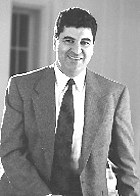
| T H E N I H C A T A L Y S T | M A Y – J U N E 2002 |
|
|
|
INCOMING NIH DIRECTOR VOWS DEDICATIONTO 'FACTS, NOT FACTIONS' |
by Celia Hooper and Fran Pollner |
 |
From the moment in late March that he was nominated by George Bush to become the next NIH director, Johns Hopkins radiology chief Elias Zerhouni has been on a fast track from Baltimore to Bethesda.
Senate hearings on his nomination were held April 30; his confirmation by the full Senate by voice vote came two days later. Zerhouni was expected to be sworn in at NIH in an informal ceremony on May 20, replacing acting director Ruth Kirschstein and ending the more than two-year hiatus between NIH directors since Harold Varmus departed on the eve of 2000.
NIH officials who attended the confirmation hearings before the Senate Health, Education, Labor, and Pensions Committee said they were impressed with Zerhouni’s candid and skilled responses to politically sensitive questions and the way he focused on the scientific bottom line.
When it comes to political hot-button issues, Zerhouni told the senators, his role as NIH director would be to inform the debate by developing and communicating the most objective scientific data—to present scientific facts, not to support political factions.
Fielding questions on human embryonic stem cells, Zerhouni indicated that he believed that the cell lines that have been approved for NIH-supported research (see "Human Embryonic Stem Cells: Opportunity Delayed but Not Denied," The NIH Catalyst, November–December 2001) would be sufficient for researchers to begin to probe for answers to the fundamental questions on which the cells may shed light.
|
"IN MY FIELD, PROGRESS CANNOT BE MADE WITHOUT BIOLOGISTS, PHYSICIANS, AND PHYSICAL SCIENTISTS WORKING TOGETHER . . . . PROGRESS INCREASINGLY WILL DEPEND UPON FIELDS OF SCIENCE BEYOND MEDICINE AND BIOLOGY. . . . WE NEED TO ENCOURAGE CROSS-CUTTING INITIATIVES" —Elias Zerhouni, 4/30/02 |
Zerhouni’s interest in stem cell research is more than academic. As executive vice dean of The Johns Hopkins University School of Medicine—a position he has held since 1997—he launched and organized the Institute for Cell Engineering, described on the Hopkins website as "dedicated to exploiting the practical and ethical uses of progenitor cells."
Throughout his career at Hopkins, Zerhouni has been tapped to handle complex tasks combining consensus-building and managerial skills with a broad and deep knowledge of basic research, clinical medicine, and biomedical engineering. He is profiled on the Hopkins website as an acknowledged and "gifted clinician, scientist, and inventor," as well as "a leader with the administrative ability to juggle multiple tasks effectively and the leadership skills to energize people around strategic goals." Some of Zerhouni’s organizational achievements at Hopkins include restructuring the School of Medicine’s Clinical Practice Association and working with local government to plan a biotechnology research park and revitalization project near Hopkins’ urban medical campus.
As Hopkins’ Interim Vice Dean for Research, Zerhouni crafted a comprehensive strategic plan for research and launched new facilities and core technology development projects.
In his chosen field of radiology—a crucible for his talents in math, physics, and clinical medicine—Zerhouni developed innovative approaches and new techniques in both computerized tomography (CT) and magnetic resonance imaging (MRI). He laid the groundwork for the development of CT densitometry, invented a method to enable all scanners to perform such tests, and conducted early clinical trials establishing CT as the standard by which to evaluate lung nodules. He invented a novel MRI cardiac tagging technology to evaluate heart function and was also the co-inventor of vacuum-assisted, image-directed biopsy, a less invasive method for diagnosing suspicious lumps found on mammography that has become the standard of care.
Zerhouni, 51, was born
in Algeria and arrived at Hopkins in 1975 after earning his medical degree from
the University of Algiers School of Medicine. In concluding his remarks at the
Senate hearing, he described himself as "an immigrant [who is] deeply touched
by being here today." ![]()